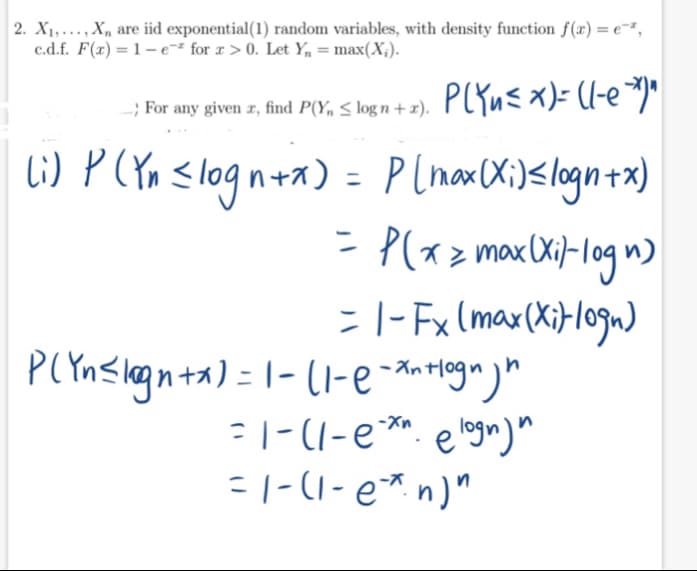2. X1,...,X, are iid exponential(1) random variables, with density function f(x) = e~*, c.d.f. F(r) = 1-e* for r> 0. Let Y, = max(X;). PLYus x)= (l-e *)* -; For any given I, find P(Y, < log n + x).
2. X1,...,X, are iid exponential(1) random variables, with density function f(x) = e~*, c.d.f. F(r) = 1-e* for r> 0. Let Y, = max(X;). PLYus x)= (l-e *)* -; For any given I, find P(Y, < log n + x).
A First Course in Probability (10th Edition)
10th Edition
ISBN:9780134753119
Author:Sheldon Ross
Publisher:Sheldon Ross
Chapter1: Combinatorial Analysis
Section: Chapter Questions
Problem 1.1P: a. How many different 7-place license plates are possible if the first 2 places are for letters and...
Related questions
Topic Video
Question
Kindly let me know if I am right or not

Transcribed Image Text:2. X1,..., X, are iid exponential(1) random variables, with density function f(x) = e-²,
c.d.f. F(x) = 1 – e=² for x > 0. Let Y, = max(X;).
-; For any given z, find P(Y, S log n + 2). PCYu<x)= (l-e¬)*
lG) P(CYa <logn+a) =
P lnax (Xi)<logn+x)
- P(xz maxCXij-log n)
= |- Fx (max(XiFl0gm)
: |-(1-e**. e logm)"
=|-(1- e* n)"
Expert Solution
This question has been solved!
Explore an expertly crafted, step-by-step solution for a thorough understanding of key concepts.
Step by step
Solved in 2 steps with 2 images

Knowledge Booster
Learn more about
Need a deep-dive on the concept behind this application? Look no further. Learn more about this topic, probability and related others by exploring similar questions and additional content below.Recommended textbooks for you

A First Course in Probability (10th Edition)
Probability
ISBN:
9780134753119
Author:
Sheldon Ross
Publisher:
PEARSON


A First Course in Probability (10th Edition)
Probability
ISBN:
9780134753119
Author:
Sheldon Ross
Publisher:
PEARSON
